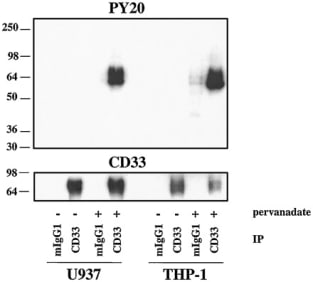Anti-SIGLEC3 [CD33 3D6]
Invented by Prof Paul Crocker from University of Dundee
Invented at University of Oxford
- Datasheet
- References (4)
- Inventor Info
Info
| Catalogue Number | 151219 |
| Applications | ELISA |
| Antigen/Gene or Protein Targets | SIGLEC3 (CD33) |
| Synonyms | Sialic Acid Binding Ig Like Lectin 12; SIGLECL1; SLG 3; Siglec-12; Siglec-L1; S2V |
| Reactivity | Human |
| Relevance | The siglecs are a family of membrane bound lectins (of the immunoglobulin superfamily) that bind sialic acid and mediate cell-cell interactions. Family members include sialoadhesin, CD22 and CD33. CD33 is found on granulocyte and macrophage precursors in the bone marrow, but not on pluripotent stem cells. CD33 is also expressed on, and a useful marker for, peripheral monocytes. CD33 is also useful for distinguishing myelogenous leukaemia cells from lymphoid or erythroid leukaemias. |
| Host | Mouse |
| Immunogen | CD33-Fc recombinant protein |
| Positive Control | CD33 transfected COS cells |
| Subclass | IgG1 |
| Myeloma Used | Sp2/0-Ag14 |
| Recommended Growing Conditions | DMEM + 5% FCS |
| Research Area | Cancer, Cell Type or Organelle Marker, Immunology, Stem Cell Biology |
References: 4 entries
Taylor et al. 1999. J Biol Chem. 274(17):11505-12. PMID: 10206955.
The myeloid-specific sialic acid-binding receptor, CD33, associates with the protein-tyrosine phosphatases, SHP-1 and SHP-2.
Europe PMC ID: 10206955
Freeman et al. 1995. Blood. 85(8):2005-12. PMID: 7718872.
Characterization of CD33 as a new member of the sialoadhesin family of cellular interaction molecules.
Europe PMC ID: 7718872
Add a reference
References: 4 entries
Taylor et al. 1999. J Biol Chem. 274(17):11505-12. PMID: 10206955.
The myeloid-specific sialic acid-binding receptor, CD33, associates with the protein-tyrosine phosphatases, SHP-1 and SHP-2.
Freeman et al. 1995. Blood. 85(8):2005-12. PMID: 7718872.
Characterization of CD33 as a new member of the sialoadhesin family of cellular interaction molecules.
Add a reference



![Image thumbnail for Anti-SIGLEC3 [CD33 3D6]](https://res.cloudinary.com/ximbio/image/upload/c_fit,fl_lossy,q_auto/6cb0abf4-0d92-4509-be5f-280c7e3d2355.jpeg)
![Image thumbnail for Anti-SIGLEC3 [CD33 3D6]](https://res.cloudinary.com/ximbio/image/upload/c_fit,fl_lossy,h_45,q_auto/6cb0abf4-0d92-4509-be5f-280c7e3d2355.jpeg)

